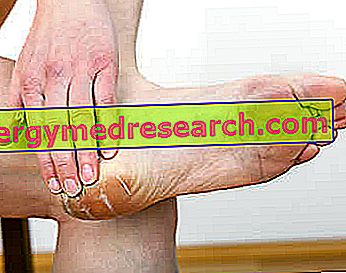Generality
Keratoses are medical conditions characterized by excessive growth of the stratum corneum of the skin. Rich in keratin, the stratum corneum is the outer cellular layer of the epidermis; the latter, together with the dermis, constitutes the skin as a whole.

Step back to understand: the Horny Layer
The skin (or skin ) of the human being is the result of the overlapping of numerous cell layers.
The most external cellular layers constitute the so-called epidermis ; those more internal (or deep), instead, form the so-called derma . Thus, the epidermis overhangs the dermis and represents the skin component in direct contact with the external environment.

The stratum corneum of the human skin is the outermost cellular layer of the epidermis.
Composing the stratum corneum of human skin are about twenty overlapping cellular laminae, all very similar to each other and made up of dead cells with a flattened shape.
Resulting from a process known as desquamation, the stratum corneum of human skin is rich in keratin, a very stable and resistant filamentous protein.
The stratum corneum is all the more often subjected to mechanical insults: for example, at the level of the palms of the hands and on the soles of the feet, its thickness is very marked.
Please note
In general, the cellular layers of human skin are the result of numerous cellular sub-layers, in which the constituent elements are the same or very similar to each other. The stratum corneum described above is an example: the cellular laminae mentioned above are, in fact, cellular sub-layers.
Definition
Medical Definition of Keratosis
In truth, to be more precise, "keratosis" is the term by which doctors indicate any condition characterized by excessive growth of the stratum corneum of the skin .
For intuitable reasons, the areas of skin that play a leading role in keratosis processes have very high amounts of keratin.

Types of Keratosis
As mentioned, there are numerous types of keratoses and the best known are: actinic keratoses, seborrheic keratoses, follicular keratoses, subungual hyperkeratosis, palmoplantar keratoses and pharyngeal keratosis.
The following types of keratoses will be analyzed in more detail below.
Actinic keratosis
Photo Actinic Keratosis
Features and symptoms
The term actinic keratosis, or solar keratosis, refers to a skin condition characterized by the presence of one or more erythematous scales on the skin. These scales tend to be rough to the touch, often of normal color but sometimes pigmented with yellow or greyish, surrounded by a red halo and telangiectasias.
The parts of the body most affected by the formation of scales are: the face, the legs, the arms, the back of the hands and the scalp; not surprisingly, these are anatomical areas that, during the life of a human being, are very exposed to sunlight.
Sometimes, actinic keratosis is also responsible for itching and wart-like lesions.
Actinic keratosis may be the prelude to a malignant skin tumor.
Causes and risk factors
The main cause of actinic keratosis is prolonged and repeated exposure to the sun and ultraviolet rays in general. Actinic keratosis does not appear after a day in the sun, but after years of recurrent exposure; in other words, it is a cumulative phenomenon (multiple exposures to the sun), which occurs long afterwards. This explains why people with actinic keratoses are mostly elderly people.
Among the risk factors of actinic keratosis we find:
- Age over 40 years;
- Live in sunny environments for most of the year;
- History of prolonged sun exposure and / or ultraviolet rays of artificial tanning tools;
- Have light skin, blond hair and light eyes;
- Clinical history of skin cancer;
- Possess a weak immune system, due to the effect, for example, of a chemotherapy treatment, of AIDS or of a therapy based on immunosuppressants.
Diagnosis
In most cases, physical examination is sufficient to diagnose actinic keratosis. However, if there is any doubt, the doctor can always resort to a skin biopsy, which is a highly reliable test.
Treatment
Actinic keratosis can heal without any specific treatment, but, in these situations, the risk of a relapse is high, especially if the patient does not avoid sun exposure in the following years.
The implementation of a specific therapy allows a more effective resolution of the problem and reduces the risk of complications (malignant skin cancer).
The treatments for actinic keratosis include:
- The use of pharmacological substances in cream or gel, to be applied on the affected area. They are drugs indicated in the case of actinic keratoses: fluorouracil, imiquimod, metubate ingenol and diclofenac;
- The so-called photodynamic therapy ;
- The removal of the scales, by means of cryotherapy or so-called scraping.
Seborrheic keratosis
Photo Seborrhoeic keratosis
Features and clinical manifestations
Seborrheic keratosis is, in fact, a benign tumor of the skin, which causes the formation of black-brownish speckles (or papules ) in relief.
The anatomical areas usually affected by seborrheic keratoses are the face, chest, shoulders and back.
At the beginning, the papules have a yellowish color; only later do they take on the black-brownish color. Their size can be extremely different from case to case: there are patients with papules of one millimeter and patients with papules of one centimeter.
The presence of the aforementioned papules does not cause pain; however, if something irritates them, they could cause itching and be very annoying.
Causes and risk factors
At the moment, despite numerous studies on the subject, the precise causes of seborrheic keratoses remain a mystery.
Among the risk factors of seborrheic keratosis we find:
- Age over 40 years;
- Family history of seborrheic keratosis.
Diagnosis
In general, a physical examination is sufficient to diagnose seborrheic keratosis; if, however, doubts remain, the doctor can resort to a skin biopsy, which is a highly reliable test.
Treatment
Seborrheic keratosis is a condition with which it is possible to live together without resorting to any type of treatment. Having said this, there are patients who feel the need to eliminate papules for a purely aesthetic reason.
Treatments for seborrheic keratoses include: cryosurgery, scraping, electrocautery and laser.
Keratosis Pilare
Photo Keratosis Pilare
Features
Keratosis pilare, or follicular keratosis, is a fairly common skin condition, characterized by an accumulation of keratin at the cutaneous opening of the hair bulbs . This accumulation of keratin is a cause of obstruction to the aforementioned opening.
The onset of keratosis pilare coincides with the appearance of point papules, similar to granules, generally rough and palpable to the touch.
Keratosis pilare can affect both children and adults. For reasons still unknown, in children, the most affected anatomical areas are the cheeks and temples; in adults, however, the areas of the body of greatest interest are the thighs, the buttocks and the arms.
Treatment
Keratosis pilaris is a condition that tends to disappear spontaneously with aging.
However, it should be pointed out that medicine has made available to people with keratoses some therapeutic treatments aimed at speeding up the process of resolving papules.
The treatments for keratosis pilare include:
- Keratolytic substances, such as urea and propylene glycol;
- Abrasive soaps;
- Moisturizing products of various kinds;
- Salicylic Vaseline;
- Isotretinoin-buffered lotions;
- Lactic acid;
- Gel containing 5-6% salicylic acid.
Keratosis pilare is not a serious problem, but it is still a little disliked from an aesthetic point of view.
variants
There are various subtypes of keratosis pilaris, some of which are particularly aggressive.
Among the very aggressive subtypes of keratoses, they deserve a mention: the red atrophying red keratosis, the decalvating follicular keratosis of Siemens and the acquired symptomatic keratosis.
Subungual hyperkeratosis
The term subungual hyperkeratosis refers to a deformity of the nail, following an accumulation of keratin at the nail bed and / or hyponymy.
The presence of subungual hyperkeratosis coincides with a thickening of the nail plate and its lifting; the latter is due to a deposit of scales, which can have variable thickness and a white-yellowish or silvery-white color.
Among the possible complications of subungual hyperkeratosis include onycholysis (ie detachment of the nail) and crumbling of the nail plate.
Subungual hyperkeratosis is a condition that very often accompanies nail psoriasis .
Palmoplantar keratosis
Photo Palmoplantar keratosis
Features
Palmoplantar keratosis - or palmoplantar keratoderma - is the medical term for localized or generalized thickening of the skin of the palms of the hands or the soles of the feet.
Clearly, the thickening of the skin in question affects the stratum corneum of the epidermis.
Causes
Palmoplantar keratosis can be an inherited or acquired condition. If it is hereditary, it means that it is due to a genetic mutation transmitted to the patient by one or both parents; if it is acquired, on the other hand, it means that the patient has developed it over a lifetime, usually due to an environmental factor.
variants
Pathologist doctors recognize the existence of 3 types of palmoplantar keratoses: diffuse palmoplantar keratoses, focal palmoplantar keratoses and pointed palmoplantar keratoses.
The diffuse palmoplantar keratosis uniformly affects the entire sole of the feet and / or the whole palm of the hand, with evident and consistent thickening.
Focal palmoplantar keratosis is characterized by localized thickening, especially on the feet. In general, the most affected parts of the foot are those most exposed to friction and pressure.
Finally, pointed palmoplantar keratosis involves the formation of small and slight bumps on a large part of the sole of the foot and / or on a large part of the palm of the hand.
Generally, acquired palmoplantar keratoses are widespread or focal and are accompanied by other medical conditions, including: eczema, psoriasis, infections, malignant tumors of an internal organ and circulation problems.
Treatments
The treatments used to reduce palmoplantar keratoses include: emollients, keratolytic substances, topical retinoids, topical vitamin D-based drugs and systemically administered retinoids.
Pharyngeal keratosis
Pharyngeal keratosis is a medical condition characterized by excessive growth of keratin on the surface of the pharynx; the pharynx is the posterior region of the mouth and is generally known as the throat.
Due to the effect of pharyngeal keratosis, white-yellowish spots appear on the pharynx, which, in some circumstances, can also invade the areas covered by the palatine tonsils, the pharyngeal tonsil and the lingual tonsil.
As far as the symptomatology is concerned, pharyngeal keratosis could be a cause of pain during swallowing.
At present, there are no effective treatments for pharyngeal keratosis. However, the discovery of an effective therapy against this problem is not a priority, as people with pharyngeal keratoses recover spontaneously from the disorder after a certain period of time.



